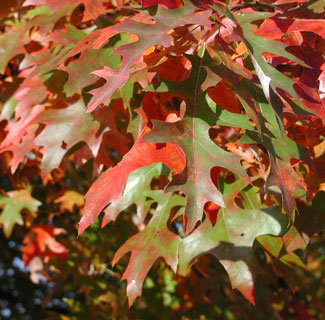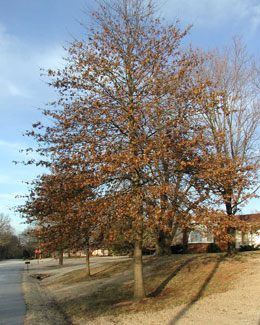Resource Library
Plant of the Week: Oak, Pin
Pin Oaks are one of the most dependable fall color producers. Of the oaks the most often used for landscape planting is probably the pin oak, Quercus palustris. Why this species is singled out for stardom while other equally good or perhaps even better species are shunned is worth exploring. (Image courtesy Gerald Klingaman)
Download High Resolution
Plant of the Week
Pin Oak
Latin: Quercus palustris
Pin oak is a straight-trunked tree growing 60-to 70-feet-tall that, unlike most oaks, produces few massive side branches. During the first 40 years of its life it has a distinctly pyramidal form with abundant smaller lateral branches.
The upper third of the tree produces ascending branches which transition to right angled branches in the middle of the tree and finally drooping branches on the lower third of the trunk as gravity takes its toll on the relatively slender side branches. Given enough room to display this unique growth form the pin oaks are very graceful but if planted in the wrong location the drooping lower limbs become a never-ending maintenance problem.
Once the tree tops out in size – usually around the 40-year mark – it becomes more round headed and the drooping limb problem is solved because they have all been cut off. As a member of the red oak group, pin oaks are relatively short lived and seldom seen over 120 years old. Because of all the side branches pin oak lumber tends to be full of knots so lumbermen usually use it for pallets, firewood and other low-value uses. The name pin oak probably comes from the use of the stout but uniform side branches to pin together timber frame buildings.
Pin oak leaves are 6 inches long, glossy green, with 5 to 7 deep lobes, each of which is tipped with a long slender bristle. The underside of the leaf is lighter in color with the junctures of the leaf veins producing small but conspicuous tufts of hairs. Red fall color production is dependable each year and usually appears in mid to late October.
The center core of the tree – that part of the branch structure developed during the first 20 years of life when the tree is in its juvenile stage and not yet producing acorns – retails its brown leaves throughout the winter. This winter retention of leaves makes pin oaks useful for large scale screening projects.
These pin oaks show the typical pyramidal form and leaf retention during the winter months. (Image courtesy Gerald Klingaman)
Download High Resolution
Pin oaks have a native range from southern New England, across from the Middle Atlantic States to Eastern Kansas and Oklahoma and south to the Tennessee – Mississippi line. Interestingly, in Arkansas the species avoids the Ozark Dome, instead occurring on the alluvial plain at the southern edge of the Ozarks along the Arkansas River and in northeast Arkansas. The species epitaph for pin oak “palustris” translates from Latin as “marsh loving,” indicating its preference for moist bottomland sites where it is often found growing with sweetgum.
For more than a century, pin oaks have been favored by nurserymen, in no small measure because they usually don’t have a deep tap root, they have a freely branching fibrous root system and they grow fast. Also, because many building sites have wet, compacted soil, pin oaks will flourish where more finicky species would fail. Fast growth and high survival rate when transplanted, what’s not to love?
But pin oaks also have some warts. First, those low hinging limbs require annual pruning if the tree is planted too close to a walkway, drive or street. Though sometimes recommended, pin oaks should not be used for street tree plantings unless the row can be kept at least 30 feet from the edge of the road.
An iron deficiency problem called iron chlorosis is another serious problem on pin oaks growing in sites with the pH above 6.8. It turns leaves a sickly yellow and stunts the trees’ growth. In Mississippi County where pin oak is native, pockets of soil were disrupted by “sand blows” during the New Madrid Earthquake of 1811 and 1812. These pockets contain high levels of subterranean limestone that elevated the soil pH, creating some sickly looking pin oaks around the Osceola Courthouse. Though theoretically treatable by acidifying the soil, using iron sprays or implanting iron containing capsules in the trunk, long-term results are not encouraging for big trees.
Pin oaks are good trees for general landscape use but their limitations should be kept in mind. They are not well suited for use as general shade trees near patios or to shade a one-story home. Oaks with ascending branches such as scarlet oak or willow oak are better choices. But when used as a specimen tree with plenty of room to spread out, pin oak is hard to beat.
By: Gerald Klingaman, retired
Extension Horticulturist - Ornamentals
Extension News - March 7, 2014

